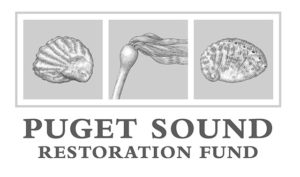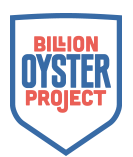The world needs more oysters. On dining plates, sure, but also in estuaries, where they clean the water and serve as key habitat for hundreds of species. To help achieve that end, OysteRater is now donating 10% of its profits to two standouts in oyster restoration, one on each coast:
- Puget Sound Restoration Fund has restored 50-60 acres of Oly beds at priority sites in Puget Sound.
- The New York Harbor School’s Billion Oyster Project has already restored 28 million oysters to New York Harbor and will eventually restore, yes, one billion.
Puget Sound Restoration Fund
Love Olys? Support PSRF!
 Here at OysteRater, we love all oysters, but we especially love the Olympia oyster. We love it on the half shell, and we love it on the Pacific Coast, where it has been creating complex habitat and serving as one of the iconic flavors of the Northwest since the Ice Age. But the tiny, pearlescent Olympias were badly over-harvested in the 1800s, and by the 1930s few healthy beds of wild Olympia oysters survived. (The oyster has been farmed as a labor of love by a handful of shellfish growers in Puget Sound, primarily Taylor Shellfish. Taylor’s Seattle oyster bars are still the best place to find Olys.)
Here at OysteRater, we love all oysters, but we especially love the Olympia oyster. We love it on the half shell, and we love it on the Pacific Coast, where it has been creating complex habitat and serving as one of the iconic flavors of the Northwest since the Ice Age. But the tiny, pearlescent Olympias were badly over-harvested in the 1800s, and by the 1930s few healthy beds of wild Olympia oysters survived. (The oyster has been farmed as a labor of love by a handful of shellfish growers in Puget Sound, primarily Taylor Shellfish. Taylor’s Seattle oyster bars are still the best place to find Olys.)
Enter the Puget Sound Restoration Fund, which has been working with Taylor Shellfish and other partners to restore Olympia oysters to Puget Sound for many years. PSRF has planted more than 10 million seed-sized Olys at sites throughout Puget Sound and has enhanced 50-60 acres of Oly beds with shell for the larvae to set on. In addition, PSRF has seeded 250 shellfish gardens, started several community shellfish farms, and spearheaded projects to restore kelp and abalone, two other key Northwest species. To help it keep doing this vital work, please visit PSRF’s website to donate, volunteer, start a shellfish garden, or simply eat more oysters. You can do that, can’t you?
Billion Oyster Project
Oysters were the keystone species and original ecosystem engineers of New York Harbor. Oyster reefs once covered more than 220,000 acres of the Hudson River estuary. They provided valuable ecosystem services to the region by filtering water, providing habitat for other marine species and attenuating wave energy. Today, oysters are functionally extinct in the Harbor as a result of over-harvesting, dredging and pollution. The absence of oysters has impaired our estuary’s ability to clean the water and absorb excess nitrogen; the loss of reefs has reduced protective habitat, destabilized the sea floor and left our shoreline vulnerable to destructive wave action. The Billion Oyster Project aims to reverse these effects by bringing oysters and their reef habitat back to New York Harbor. Restoring oysters and reefs will, over time, restore the local marine ecosystem’s natural mechanisms for maintaining itself, resulting in cleaner water and greater biodiversity. Moreover, engaging students and the general public in this work will build a culture of stewardship and a more robust understanding and appreciation of the Harbor for future generations.

Billion Oyster Project plans to restore one billion live oysters to New York Harbor and engage hundreds of thousands of school children through restoration-based STEM education programs. Students at New York Harbor School have been growing and restoring oysters in New York Harbor for the last six years. They have learned to SCUBA dive safely, raise oyster larvae, operate and maintain vessels, build and operate commercial-scaled oyster nurseries, design underwater monitoring equipment and conduct long-term authentic research projects all in the murky, contaminated, fast moving waters of one of the busiest ports in the country. Together, and with the help of many partners, these students have restored over nineteen million oysters. Fifty-four schools have partnered with the project to provide authentic, place-based science and math lessons through the lens of oyster restoration. Each year, thousands of students participate in these learning opportunities.
New ratings